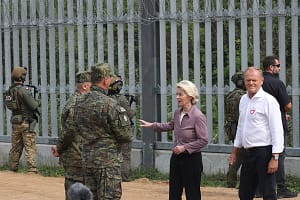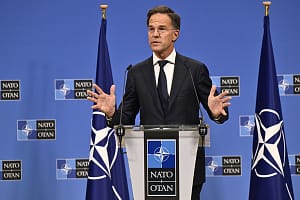Under the direction of President Ursula von der Leyen and Budget Commissioner Pyotr Serafin, on July 16th the European Commission (EC) revealed its multiannual financial framework (MFF) of almost €2 trillion for the 2028-2034 period. The proposed defence and space budget will drastically increase to €130 billion with an addition €100 billion for Ukraine. Von der Leyen claims, “This is a budget for a new era, one that matches Europe’s ambition, addresses Europe’s challenges and strengthens our independence.”
Stakeholders will negotiate the proposal over the next two years, but there already seems to be agreement among Member States that given today’s new geopolitical realities, increased spending on defence is vital. Danish Prime Minister Mette Frederiksen argued, “The world is changing rapidly, the most important thing is to rearm Europe” and “all other priorities and principles must be addressed after we have made the necessary decisions on how to rearm.”
Unfortunately, discourse about increasing European defence sovereignty is being confronted with divergent national interests and budgetary concerns as well as unclear priorities for building capabilities. Financial pledges are mainly virtual for the moment, and tough choices will need to be made about what to prioritise now with money actually available.
EU measures vs. national realities
European efforts to strengthen its defence sovereignty began in 2017 when the first Trump administration started hinting at America’s changed priorities, but have taken on new urgency with the second Trump administration’s actions, continued fighting in Ukraine and NATO intelligence that Russia is capable of attacking Europe in 3-5 years.
In March, the EC published its White Paper for European Defence – Readiness 2030, the epicentre of the EU and member countries’ efforts to undertake rearmament, which must be translated into concrete actions. As the first EU Commissioner for Defence and Space, Andrius Kubilius says, “Now I have an urgent responsibility to steer the implementation in the most effective way of this most strategically important part of our common agenda of today.”
The white paper stresses the importance of countries buying European-made technology and identifies “seven priority capability areas” for European defence: air and missile defence, artillery systems including deep precision strike (DPS), ammunition and missiles, drones and counter-drone systems, military mobility, strategic enablers/critical infrastructure protection and AI, Quantum, Cyber & Electronic Warfare.
President von der Leyen unveiled the ReArm Europe Plan to help fill these needs by allowing Member States to invoke the ‘national escape clause’ for defence spending and creating the SAFE programme with €150 billion in EU-backed loans for joint defence procurement projects. Eighteen countries submitted applications with Poland requesting the most (€45 billion). Even more astronomical amounts of Euros are being pledged following recent commitments made by NATO allies to allocate 5% of GDP to “core defence requirements.”
Such efforts are helpful, but non-binding and optional, meaning some countries participate more than others. Poland is leading the pack with 4.12% of GDP going to its defence budget in 2024. France has pledged to reach 3.5% of GDP, but is facing challenges at home as debt reached 112% of GDP. Italy has similar problems with debt reaching 135% of GDP in 2023.
Setting immediate priorities
With many EU Member States facing pressure at home to reduce debt, money needed in the short-term to develop all the capability gaps proposed in the White Paper is lacking. In order to break continued reliance on Washington, the first overarching priority should be ensuring that the European industrial defence industry can fully provide for Europe’s needs.
The value of arms imported (mainly from the US) to Europe increased from €3.1 billion (2019–2021) to €7.9 billion (2022–2024). Aurélie Pugnet argues “European allies are splitting along a spectrum, from those leaning heavily on US weapons to those insisting on buying European, with each path offering both short-term fixes and longer-term strategic bets.” National demand from European defence companies must increase for production to ramp up and for economies of scale to be possible. Indeed, a Bruegel report observed that “scaled-up procurement could lead to a halving of unit costs.”
Luckily, there are examples underway of state-level programmes uniting government efforts and of industry-level cooperation with companies working cross-border focusing on two main capabilities: integrated air and missile defence (IAMD) and DPS capabilities. Recent conflicts between Ukraine/Russia and Israel/Iran highlight the imperative role of both in modern warfare. Europe is now scrambling because since the Cold War, the continent has relied on the US to provide them.
In 2022, Germany launched the European Sky Shield Initiative (ESSI) with the participation of 20 EU states to develop an IAMD system in Europe. ESSI is based on Germany’s IRIS-T, Israel’s Arrow 3 and America’s Patriot system. Italy and France rejected ESSI because of this and the EU Whitepaper says, “ESSI undermines one of Europe’s new priorities of ending dependence on foreign, especially American, technology and industries.” However, through a joint venture between MBDA and Thales, Europe now has the Medium-Range Ground-to-Air/Ground System (SAMP/T NG) equipped with a new ASTER B1NT missile: a system rivalling the Patriot but adapted to European forces, costing a third less and having a reduced logistical footprint. This is an opportunity for Europe to build IAMD capabilities without American technology, as Denmark has done with its recent decision to purchase the SAMP/T over the Patriot.
Lessons from Ukraine and Israel have shown that there can be no effective defence without the ability to attack the enemy’s vulnerabilities symmetrically. Consequently, developing European DPS capabilities that give countries the ability to neutralise high-value targets deep in enemy territory and deter aggressors with the simple threat of this capacity has become a top priority. For this, there is a wide range of options, from long-range drones to glide bombs dropped from aircrafts to ballistic and cruise missiles. Each solution has its advantages and disadvantages. Drones are primarily designed to saturate enemy defences and ballistic solutions capable of evading sophisticated defences are very expensive. Therefore, cruise missiles seem the most attractive in terms of cost-effectiveness (military-wise), as exemplified by Ukraine’s new FP5 “Flamingo” system.
This explains why cruise missile designs are being given preference when choosing models for projects under development through the European Long Strike Approach (ELSA) initiative. ELSA was launched in 2024 uniting France, Germany, Italy, Poland, Sweden and the UK to develop DPS capabilities. MBDA’s Land Cruise Missile (LCM), a ground-launched evolution of its battle-proven Naval Cruise Missile (MdCN), is said to be a frontrunner for one of the initiative’s lighthouse projects and a first firing is scheduled for 2027/2028.
European leaders and citizens want to see increased sovereignty over the continent’s defence. Loans and pledges are at an all-time high, but finding the cash needed to fully finance all the priorities in the EC’s White Paper is unrealistic given “the fragile financial situation of several Member States.” Short-term priorities need to be agreed upon – and quickly. Researcher Lotje Boswinkel observes, “As Europe heads into its largest rearmament effort since the Cold War, it will face key questions regarding capability prioritization, acquisition, and force enablement.”
Nurturing a self-sufficient, globally competitive European defence industry is crucial to building specific capabilities in the short term, like DPS and air defence, and also in the long term. Because as analysis from the German Institute for International and Security Affairs argues, “If the EU and its Member States cannot agree on this, it is likely that Europe will once again miss the goal of becoming capable of defending itself quickly and comprehensively, despite the financial resources that have been provided and announced. This focus on European defence requires Member States to set aside their wish to bind Washington to Europe primarily through the purchase of American weapons systems.”






Leave a Comment